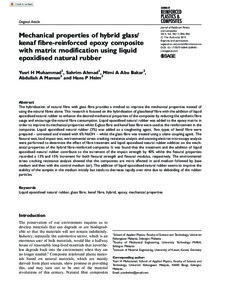Mechanical properties of hybrid glass/kenaf fibre-reinforced epoxy composite with matrix modification using liquid epoxidised natural rubber
| dc.date.accessioned | 2020-11-25T10:26:26Z | |
| dc.date.available | 2020-11-25T10:26:26Z | |
| dc.date.issued | 2015-04-27 | |
| dc.identifier | doi:10.17170/kobra-202011182208 | |
| dc.identifier.uri | http://hdl.handle.net/123456789/12029 | |
| dc.description | Dieser Beitrag ist mit Zustimmung des Rechteinhabers aufgrund einer (DFGgeförderten) Allianz- bzw. Nationallizenz frei zugänglich. | ger |
| dc.language.iso | eng | eng |
| dc.rights | Urheberrechtlich geschützt | |
| dc.rights.uri | https://rightsstatements.org/page/InC/1.0/ | |
| dc.subject | liquid epoxidised natural rubber | eng |
| dc.subject | glass fibre | eng |
| dc.subject | kenaf fibre | eng |
| dc.subject | hybrid | eng |
| dc.subject | epoxy | eng |
| dc.subject | mechanical properties | eng |
| dc.subject.ddc | 540 | |
| dc.subject.ddc | 600 | |
| dc.title | Mechanical properties of hybrid glass/kenaf fibre-reinforced epoxy composite with matrix modification using liquid epoxidised natural rubber | eng |
| dc.type | Aufsatz | |
| dcterms.abstract | The hybridisation of natural fibre with glass fibre provides a method to improve the mechanical properties instead of using the natural fibres alone. This research is focused on the hybridisation of glass/kenaf fibre with the addition of liquid epoxidised natural rubber to enhance the desired mechanical properties of the composite by reducing the synthetic fibre usage and encourage the natural fibre consumption. Liquid epoxidised natural rubber was added to the epoxy matrix in order to improve its mechanical properties whilst E-glass fibre and kenaf bast fibre were used as the reinforcement in the composite. Liquid epoxidised natural rubber (3%) was added as a toughening agent. Two types of kenaf fibre were prepared – untreated and treated with 6% NaOH – whilst the glass fibre was treated using a silane coupling agent. The flexural test, Izod impact test, environmental stress cracking resistance analysis and scanning electron microscopy analysis were performed to determine the effect of fibre treatment and liquid epoxidised natural rubber addition on the mechanical properties of the hybrid fibre-reinforced composite. It was found that the treatment and the addition of liquid epoxidised natural rubber contribute to the increment of the impact strength by 40% whilst the flexural properties recorded a 13% and 15% increment for both flexural strength and flexural modulus, respectively. The environmental stress cracking resistance analysis showed that the composites are more affected in acid medium followed by base medium and then with the control medium (air). The addition of liquid epoxidised natural rubber seems to improve the stability of the samples in the medium initially but tends to decrease rapidly over time due to debonding of the rubber particles. | eng |
| dcterms.accessRights | open access | |
| dcterms.creator | Muhammad, Yusri Helmi | |
| dcterms.creator | Ahmad, Sahrim | |
| dcterms.creator | Bakar, Mimi Azlina Abu | |
| dcterms.creator | Al Mamun, Abdullah | |
| dcterms.creator | Heim, Hans-Peter | |
| dc.relation.doi | doi:10.1177%2F0731684415584431 | |
| dc.subject.swd | Naturkautschuk | ger |
| dc.subject.swd | Glasfaser | ger |
| dc.subject.swd | Naturfaser | ger |
| dc.subject.swd | Mechanische Eigenschaft | ger |
| dc.subject.swd | Kenaf | ger |
| dc.subject.swd | Hybride | ger |
| dc.subject.swd | Epoxide | ger |
| dc.type.version | publishedVersion | |
| dcterms.source.identifier | EISSN 0731-6844 | |
| dcterms.source.issue | Issue 11 | |
| dcterms.source.journal | Journal of Reinforced Plastics and Composites (JRP) | eng |
| dcterms.source.pageinfo | 896-906 | |
| dcterms.source.volume | Volume 34 | |
| kup.iskup | false |
Dateien zu dieser Ressource
Das Dokument erscheint in:
-
Publikationen [73]

